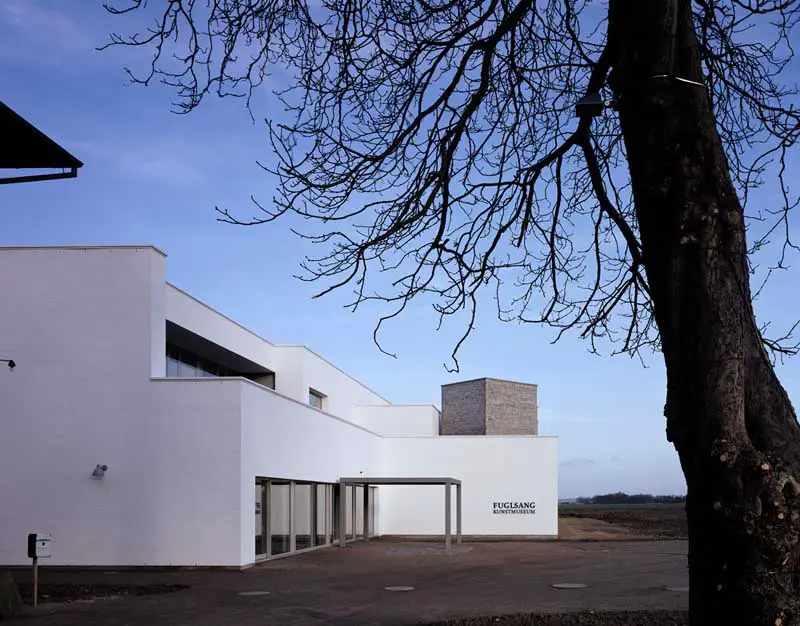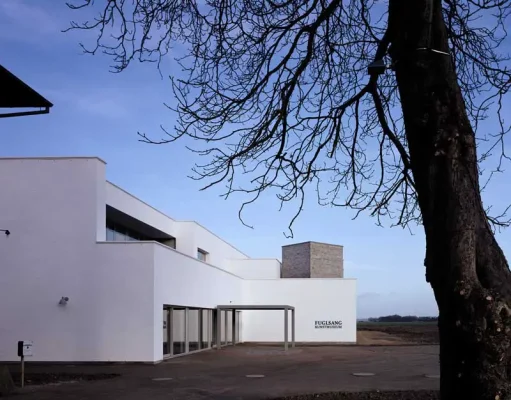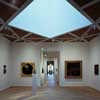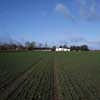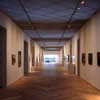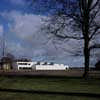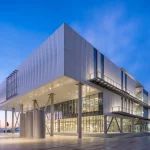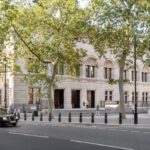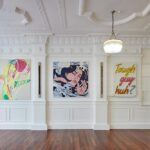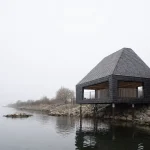Fuglsang Kunstmuseum, Lolland Art Collection, Art Gallery Denmark, Danish Design Photos
Fuglsang Kunstmuseum Building, Denmark
Contemporary Lolland Architecture design by Tony Fretton Architects, UK
Design: Tony Fretton Architects, London
Location: Fuglsang Kunstmuseum, Lolland, Danmark
The purpose-built 2,500 sqm art museum has been designed by Tony Fretton Architects to house the Storstrøm Art Museum’s permanent collection of Danish fine art dating from the period 1780-1980.
Photos © Helene Binet
28 Mar 2008
Fuglsang Kunstmuseum Lolland
The 2,500 sqm building also houses new galleries for temporary exhibitions, a shop, a café, a learning centre, administration spaces and storage for the museum’s vast collection of painting and sculpture.
Located in Fuglsang, Lolland, Southern Denmark, the new building has the formal abstractness and romantic profile of neighbouring buildings and is designed to harmonise with the idyllic rural setting of the Fuglsang estate.
Stirling Prize Nominee 2009
We asked an employee at the building what they thought of it:
Astrid Lomholt, Educational sector on Fuglsang Kunstmuseum – English text:
All in all it is a lovely building to work in. There is a good internal light which aids the desire to work there. We have space to be ourselves within the offices and space for small informal meetings to take place, as and when needed, in the library.
The kitchen has a good outdoor area used by many employees during the summer. The view to both the garden and the open fields give a good feeling for space and peace. There is space enough for the employees to move their furnishings around to suit their needs and temperaments, this helps create a feeling of ownership of the building.
Astrid Lomholt, Skoletjenesten Fuglsang Kunstmuseum – Danish text:
Alt i alt er det et dejligt hus at sidde i. Der er et fantastisk lys og rummende giver en god lyst til at arbejde. Der er plads til at være sig selv på kontoret og der er plads til uformelle møder i biblioteket.
Køkkenet er forsynet med en god terrasse, som mange benytter om sommeren. Udsigten både til haven og til de åbne marker, igennem de store vinduespartier giver pladsfornemmelse og ro. Der er plads til at flytte rundt på tingene, så de passer til ens temperament, det giver en en fornemmelse af egerskab i bygningen.
Fuglsang Kunstmuseum – Information from the RIBA
Fretton’s design consciously eschews the two stereotypes of the modern-day art space: the flashy icon project designed to pull in the punters, and the white cube, designed to attract, rather, the opposite, a rarefied audience of connoisseurs. The client’s considered brief demanded an approachable, domestic-scale gallery which, nonetheless, had presence, and in which the studying of art by curators in the offices, and the experience of art in the galleries were connected, without getting in the way of one another.
This Tony Fretton achieves hands-down. It is well constructed and detailed, and clearly erudite, with nods in its composition to architectural history. It feels, said one judge, almost as if it could have been built in any decade since the 20s. That is quite a compliment.
PRESS STATEMENT Fuglsang Kunstmuseum, Lolland Denmark
Official Press View : Mar 2008 from Tony Fretton Architects
Fuglsang Kunstmuseum
Unlike the location of an urban museum that is reached through the room-like spaces of a city, to go to Fuglsang entails a long journey through open countryside, finally arriving on a long straight road through a loose assembly of buildings to a courtyard at the heart of the Estate. Enclosing the west side of the courtyard is a long, low walled barn, painted white with a tall roof. On the north side is the land steward’s house, long again, simply ornamented and made of pale brick.
To the south is the Manor House, set back by an appropriate distance and separated by a moat. Country classical in style, the red brick façade is arranged in three tall gables and the interior has decorated ceilings and parquet floors that change in pattern from room to room. The best of its rooms look out to a refined landscaped garden behind and have long been places for the performance of music.
In the attic are small plain bedrooms for visitors who come to stay and walk in the wonderful countryside to Skejten and the bird sanctuary at the edge of the sea in Guldborgsund, which lie to the east of the courtyard.
Out in the fields on this side of the courtyard lie another barn, this one painted red, and the original forge building with the path to Skejten running between them.
What would it mean to place a Museum, a new building of a different kind here, to bring visitors to it and to alter the landscape around it? These were questions that Torben Schønherr the landscape designer, Ebbe Wæhrens my colleague and executive architect and I asked ourselves when we first stood looking at Fuglsang.
The Museum and its surroundings
The landscape and sea to the east had such significance that I felt that they should be the first thing that visitors saw as they came to the Museum.
To leave the courtyard open to the view and place the Museum in line with the land steward’s house, pointing to the horizon was controversial. A strong suggestion had been made in the brief of the architectural competition by which we were selected, that the new Museum should reinstate the original form of the courtyard by enclosing its east side.
Instead, like the red barn and the forge, the Museum extends into the fields while having a strange axial but offset relation to the most significant of the buildings, the Manor House and its formal surroundings.
Connection between the two buildings is further established by the way that the Museum is first presented to visitors as a brick façade, the same length as the Manor House, with three diagonal roof lights above that relate to the three gables in the façade of the Manor House.
Like the buildings around the courtyard, and many classic works of Danish modernism, the facades of the Museum are constructed from brick. As in the barn on the west side of the court, they are painted white and the roof lights are in a grey brick the colour of the roofs of the buildings around it.
At the entrance to the Museum the façade steps back, making a place for visitors to gather at the edge of the courtyard. At this point the view of the land and sea is temporarily taken away and the Museum and visitors become the focus.
A canopy of painted metal in the form of an open sided cube, low and wide, provides shelter from the rain, and is matched by a glass wind lobby of equal scale and transparency in the entrance foyer within the building.
One end of the foyer is arranged as a café, the other as a bookshop and reception area, both of which look out through extensive windows to the courtyard on one side and the other into a public art studio and beautiful existing garden behind it. A glass door in the reception area shows the way to the library and offices on the first floor, and other doors indicate the lecture hall, toilets and place to hang your coat.
The foyer is a public place in which everything is where it can be found and enjoyed in the company of friends and strangers within the landscape and spaces of Fuglsang. From within it there is a line of sight to the long central gallery of the Museum, around which the other galleries are laid out, and along it to a view of the landscape and sea at its end that resembles the first narrow view seen when entering the Estate.
The galleries are very different in scale and character from the public space of the foyer and are places into which groups of visitors can spread out and immerse themselves in the collection, finding that it is arranged in three suites.
The first of these is to the right of the central gallery and consists of medium scale rooms arranged enfilade. Paintings from 1800-1900 are displayed in the first three rooms of the suite, which have ornamented ceilings and are lit by the diagonal roof lights that were seen above the façade. Further along is a room for works on paper, which for reasons of conservation is artificially lit. At the end is a gallery for plaster casts that is lit by a window looking out towards Sketjen. Between the galleries are very small rooms, called pockets, where a few people can view a single work of art.
On the opposite side of the corridor is a single, large, minimally detailed gallery for temporary exhibitions. Abstract and reconfigurable, daylight comes into this tall space through a diffusing ceiling of open metal grids, above which there is space to support suspended artworks and install projectors.
Further along on this side is the third suite, consisting of a plainly detailed top lit space that is configured with screens into four rooms. Here works of Modernism from the early to mid twentieth century will be hung, ranging from medium scale figurative works to large abstract canvases.
Connecting these spaces is the central gallery, which is neither simply an exhibition space nor a place of circulation. Couches could be interspersed with artworks in the classical manner or the whole space given over to an exhibition or an event. At the end is a room that seems like a gallery but has only windows giving views of the sea and landscape, which is intended as a place to rest and reflect.
The different characters of the galleries and public spaces developed empirically as we designed and they are bound together in a similar way to Fuglsang itself, where very different styles of buildings and spaces are connected by simple similarities.
In this way, and through the loss and recovery of the view of landscape and sea that occurs within the Museum, some underlying qualities of the locale are introduced to the quiet, top lit exhibition spaces of the interior. Our intention is for the Museum to be filled with slight differences that are stimulating but unobtrusive, so the art not the building predominates, and for there to be a combination of familiarity and emptiness that allows the building to become the imaginative property of those who come to it.
A group of dwellings in Amsterdam, an office building in the historical quarter of Copenhagen and the New British Embassy in Warsaw illustrate how Tony Fretton Architects is diversifying, building on a reputation as a sensitive designer of spaces for art, for which it has become renowned.
Founded in 1982, the practice established an international reputation in the early ‘90s with the design of the Lisson Gallery, London. Acclaimed projects for the public arts sector ensued, including Artsway in Hampshire, a new gallery in the Yorkshire Sculpture Park for the Arts Council Collection of Sculpture, and the renovation of the Camden Arts Centre in North London, which reopened in 2004.
Arts spaces remain an integral part of the practice’s activity, as demonstrated in Fuglsang Kunstmuseum, the practice’s first major art space overseas.
In addition to designing buildings for the display of art, the practice has designed exhibition spaces, houses and studios for artists, and created studio spaces for artists’ collectives. The practice has just completed a new house in central London for the British sculptor Anish Kapoor.
The practice continues to work at various scales, from modest buildings such as the award-winning Faith House in Poole to major urban master-plans such as the £10 million residential scheme for Andreas Ensemble in Amsterdam, which is currently at design stage.
Other projects in Denmark include Tietgens Ærgrelse, a new mixed-use building in Copenhagen. Located on the corner of Frederiksgade Square, the 6 storey development has been designed to complement the Beaux Art ensemble surrounding the Marble Church.
As well as being the principal designer of all projects at Tony Fretton Architects, Tony is Professor of Architectural Design & Interiors at the Technical University Delft, the Netherlands and is active in the discourse of architecture.
World Architecture Festival Awards 2008 : WAF Awards Culture Category Shortlist
Fuglsang Kunstmuseum – Building Information
Project: Fuglsang Kunstmuseum
Location: Nystedvej 71, DK – 4891 Toreby L., Denmark
Museum website: www.fuglsangkunstmuseum.dk
Opening Hours: Tue-Thur, 9am-2pm, Fri-Sun, 11am-5pm
Client: BYGNINGSFONDEN/ The Building Foundation
Contact: Lene Grønfeldt
Funding: Fonden Realdania, Størstroms Amt, Lolland Falsterske and European Fund for Regional Development
Value: € 7.2m
Programme: Appointed May 2005, on site Aug 2006, opening Jan 2008
Internal area: 2,500 sqm
DESIGN TEAM:
Architects: Tony Fretton Architects
Design team: Tony Fretton, Jim McKinney, Donald Matheson, Guy Derwent, Annika Rabi, Sandy Rendel, Matt Barton, Nina Lundvall, Simon Jones, Gus Brown.
Project Architect: Donald Matheson
Competition team: Tony Fretton, Jim McKinney, David Owen, Matt Barton, Michael Lee, Nina Lundvall, Simon Jones, Martin Nässén
CONSULTANTS:
Executive Architect: BBP Arkitekter A/S, Copenhagen.
Structural Engineer: Birch & Krogboe A/S
Services Engineer: Birch & Krogboe A/S
Project Management: BASCON A/S
Main Contractor: CC BRUN ENTERPRISE A/S
Cost Consultant: Birch & Krogboe A/S
Landscape Architect: Schønherr Landskab A/S, Copenhagen.
Furniture design: Tony Fretton Architects
Fuglsang Kunstmuseum design : Tony Fretton Architects
Fuglsang Kunstmuseum Denmark images / information from Tony Fretton Architects
Location: Fuglsang Kunstmuseum, Denmark
Architecture in Denmark
Denmark Architecture – Selection:
Utzon Center, Aalborg, Jylland
Design: Kim Utzon Architects
Aarhus Concert Hall
Arkitektfirmaet C. F. Møller
Danish Arts Building : Willlumsens Museum
Comments / photos for the Fuglsang Kunstmuseum building design by Tony Fretton Architects in southern Denmark page welcome

